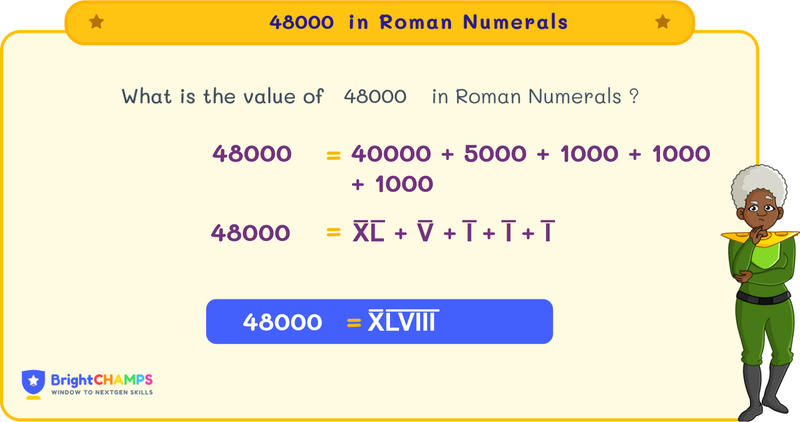Summarize this article:
 218 Learners
218 LearnersLast updated on 5 August 2025
48000 in Roman Numerals

Roman numerals are a system for expressing numbers using specific symbols: I, V, X, L, C, D, and M. These numerals have been used in royal titles, book names, sequences, and more. Here, we will discuss Roman numerals, their rules, and provide examples related to the number 48000.

What is 48000 in Roman Numerals?
Have you ever wondered about the Roman numerals used in royal titles, like Henry I or Henry II? These symbols represent numbers: I (1), V (5), X (10), L (50), C (100), D (500), and M (1000).
The Roman numeral system, developed by the ancient Romans, is still used today. For 48000, we use the symbols XL (40000) and VIII (8000) combined to form XLVIII with a bar over them to indicate multiplication by 1000, which is XLVIII̅.
Let’s explore Roman numerals and how to write them.


Basic Rules for 48000 in Roman Numerals
There are basic rules to writing numbers in Roman numerals. Here are some key rules to remember when writing numbers in Roman numerals:
Rule 1: Addition Method
When a smaller number follows a larger number, the values are added. For example, VI → V + I = 5 + 1 = 6.
Rule 2: Repetition Method
Certain numerals can be repeated up to three times to represent a value. For example, III = 3.
Rule 3: Subtraction Method
When a smaller numeral precedes a larger numeral, the smaller is subtracted from the larger. For example, IV → V - I = 5 - 1 = 4.
Rule 4: Overbar Rule
To multiply a numeral by 1000, a bar is placed over it. For example, V̅ represents 5000.

How to Write 48000 in Roman Numerals
Now let's learn how to write 48000 in Roman numerals. We can use two methods:
- By Expansion Method
- By Grouping Method

48000 in Roman Numerals by Expansion Method
Using the expansion method, numbers are broken down based on place value. Here’s how to write 48000 in Roman numerals using this method:
Step 1: Break down the number into place values: 40000 + 8000.
Step 2: Convert each part into Roman numerals.
- 40000 in Roman Numerals: XL with a bar over it.
- 8000 in Roman Numerals: VIII with a bar over it.
Step 3: Combine these values: XL̅ + VIII̅ = XLVIII̅.

48000 in Roman Numerals by Grouping Method
When writing a large number as a Roman numeral, we group it. For 48000, we group it as 40000 + 8000.
- 40000 in Roman Numerals is XL̅.
- 8000 in Roman Numerals is VIII̅.
So, 48000 is written as XLVIII̅ in Roman numerals.

Common Mistakes and How to Avoid Them in 48000 Roman Numerals
Writing Roman numerals can be tricky, especially with large numbers. Let's look at common mistakes and how to avoid them.

48000 in Roman Numerals Examples

Problem 1
A historian wants to categorize MM years into periods of M years each. How many periods will there be?

There will be II periods.
Explanation
To find the number of periods, divide the total years by the years in each period.
MM = 2000
M = 1000
Therefore, MM / M = 2000 / 1000 = 2. 2 in Roman numerals is II.

Problem 2
An archaeologist found artifacts from two different eras, one dated XL thousand years ago and the other dated VIII thousand years ago. What is the time difference between the two eras in Roman numerals?

The time difference between the two eras is XXXII thousand years.
Explanation
Time difference is the absolute difference between two periods.
XL = 40 thousand
VIII = 8 thousand
40 - 8 = 32 thousand
32 in Roman numerals is XXXII.

Problem 3
A collector has XLVIII thousand coins and decides to donate half to a museum. How many coins will the museum receive in Roman numerals?

The museum will receive XXIV thousand coins.
Explanation
To find out how many coins the museum will receive, divide the total coins by 2.
XLVIII = 48 thousand
48 thousand / 2 = 24 thousand
24 in Roman numerals is XXIV.

Problem 4
A contractor is building a pyramid with a base of XL thousand square cubits and plans to increase it by another VIII thousand square cubits. What will be the new base area in Roman numerals?

The new base area will be XLVIII thousand square cubits.
Explanation
Add the additional area to the original base area.
XL = 40 thousand
VIII = 8 thousand
40 + 8 = 48 thousand
48 in Roman numerals is XLVIII.

Problem 5
An ancient text mentions a treasure hidden for XLIX centuries. If each century represents C years, how many years in total has the treasure been hidden?

The treasure has been hidden for MMMMMMMMCM years.
Explanation
To find the total number of years, multiply the number of centuries by the years in one century.
XLIX = 49 centuries
C = 100 years
49 x 100 = 4900 years
4900 in Roman numerals is MMMMCM.


FAQs on 48000 in Roman Numerals
1.What is 40000 in Roman numerals?
2.How to write 48000 in Roman numerals?
3.What is 49000 in Roman Numerals?
4.What do overbars mean in Roman numerals?
5.How do you write 50000 in Roman numerals?
6.How can children in United Kingdom use numbers in everyday life to understand 48000 in Roman Numerals?
7.What are some fun ways kids in United Kingdom can practice 48000 in Roman Numerals with numbers?
8.What role do numbers and 48000 in Roman Numerals play in helping children in United Kingdom develop problem-solving skills?
9.How can families in United Kingdom create number-rich environments to improve 48000 in Roman Numerals skills?

Important Glossaries for 48000 in Roman Numerals
- Addition Rule: When a smaller numeral follows a larger numeral, add the values. Example, VI = 5 + 1 = 6.
- Grouping Method: Break down numbers based on values and convert each group to Roman numerals. Example, 48000 = 40000 + 8000 = XLVIII̅.
- Repetition Rule: Some symbols (I, X, C, M) can be repeated up to three times, e.g., XXX = 30.
- Overbar Rule: Indicates multiplication by 1000, e.g., V̅ = 5000.
- Subtraction Rule: Place a smaller numeral before a larger one to subtract, e.g., IV = 4.

Explore More numbers
![Important Math Links Icon]() Previous to 48000 in Roman Numerals
Previous to 48000 in Roman Numerals
![Important Math Links Icon]() Next to 48000 in Roman Numerals
Next to 48000 in Roman Numerals

About BrightChamps in United Kingdom


Hiralee Lalitkumar Makwana
About the Author
Hiralee Lalitkumar Makwana has almost two years of teaching experience. She is a number ninja as she loves numbers. Her interest in numbers can be seen in the way she cracks math puzzles and hidden patterns.
Fun Fact
: She loves to read number jokes and games.




